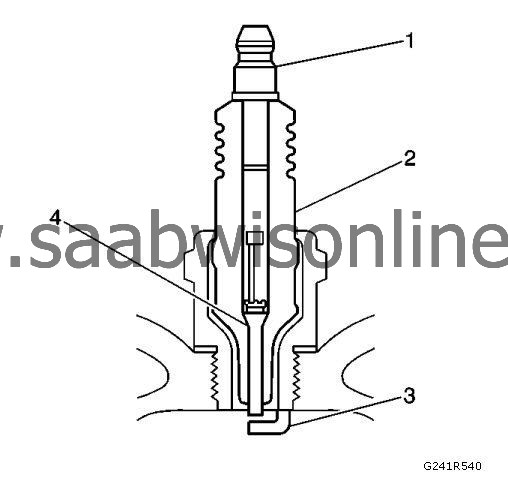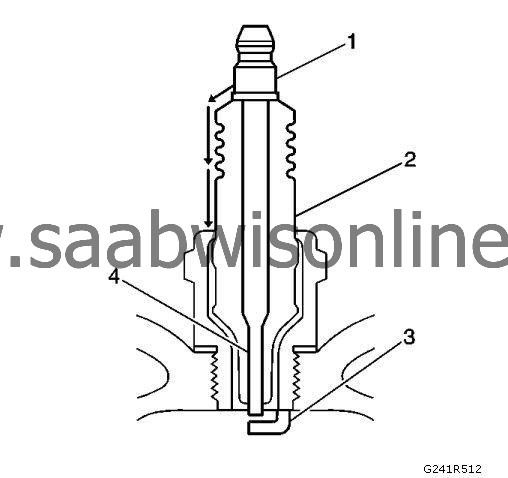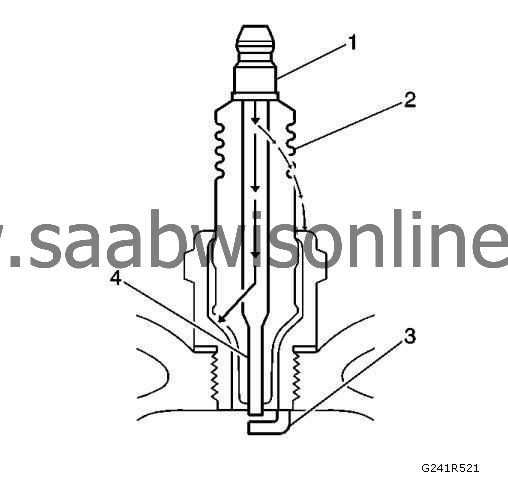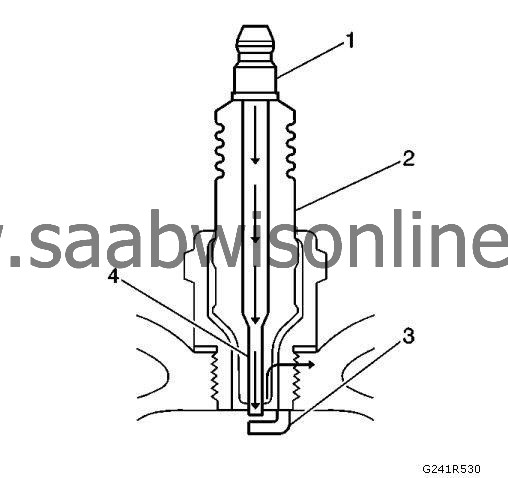Spark Plug Inspection
| Spark Plug Inspection |
| Spark Plug Usage |
| 1. |
Ensure that the correct spark plug is installed. An incorrect spark plug causes driveability conditions. Refer to
Ignition System Specifications
for the correct spark plug.

|
|
| 2. |
Ensure that the spark plug has the correct heat range. An incorrect heat range causes the following conditions:
|
|
| • |
Spark plug fouling - colder plug
|
| • |
Pre-ignition causing spark plug and/or engine damage - hotter plug
|
| Spark Plug Inspection |
| 1. |
Inspect the terminal post (1) for damage.

|
|
| • |
Inspect for a bent or broken terminal post (1).
|
| • |
Test for a loose terminal post (1) by twisting and pulling the post. The terminal post (1) should NOT move.
|
| • |
Inspect the spark plug boot for damage.
|
| • |
Inspect the spark plug recess area of the cylinder head for moisture, such as oil, coolant, or water. A spark plug boot that is saturated causes arcing to ground.
|
| 3. |
Inspect the insulator (2) for cracks. All or part of the electrical charge may arc through the crack instead of the electrodes (3, 4).

|
|
| 4. |
Inspect for evidence of improper arcing.

|
|
| • |
Measure the gap between the center electrode (4) and the side electrode (3) terminals. Refer to
Ignition System Specifications
. An excessively wide electrode gap can prevent correct spark plug operation.
|
| • |
Inspect for the correct spark plug torque. Refer to
Ignition System Specifications
. Insufficient torque can prevent correct spark plug operation. An over torqued spark plug, causes the insulator (2) to crack.
|
| • |
Inspect for signs of tracking that occurred near the insulator tip instead of the center electrode (4).
|
| • |
Inspect for a broken or worn side electrode (3).
|
| • |
Inspect for a broken, worn, or loose center electrode (4) by shaking the spark plug.
|
| • |
A rattling sound indicates internal damage.
|
| • |
Inspect for bridged electrodes (3, 4). Deposits on the electrodes (3, 4) reduce or eliminates the gap.
|
| • |
Inspect for worn or missing platinum pads on the electrodes (3, 4) If equipped.
|
| • |
Inspect for excessive fouling.
|
| • |
Inspect the spark plug recess area of the cylinder head for debris. Dirty or damaged threads can cause the spark plug not to seat correctly during installation.
|
| Spark Plug Visual Inspection |
| 1. |
Normal operation-Brown to grayish-tan with small amounts of white powdery deposits are normal combustion by-products from fuels with additives.
|
|
| 2. |
Carbon Fouled-Dry, fluffy black carbon, or soot caused by the following conditions:
|
|
| • |
Rich fuel mixtures
|
| • |
Leaking fuel injectors
|
| • |
Excessive fuel pressure
|
| • |
Restricted air filter element
|
| • |
Incorrect combustion
|
| • |
Reduced ignition system voltage output
|
| • |
Weak coils
|
| • |
Worn ignition wires
|
| • |
Incorrect spark plug gap
|
| 3. |
Excessive idling or slow speeds under light loads can keep spark plug temperatures so low that normal combustion deposits may not burn off.
|
|
| 4. |
Deposit Fouling-Oil, coolant, or additives that include substances such as silicone, very white coating, reduces the spark intensity. Most powdery deposits will not effect spark intensity unless they form into a glazing over the electrode.
|
|


